Install and Run Email Sidebar for all MS Exchange / Office 365 configurations¶
For users of the Email Sidebar on:
7 min read
Tip
Also see this Revenue Grid blog article for an overview of solution installation procedures
Note
If you are a local administrator rolling out RG Email Sidebar for multiple users in your organization, you can make use of Add-in mass deployment procedures
I. RG Email Sidebar Add-In Installation¶
You can install Revenue Grid Email Sidebar Add-in in your MS Exchange / Office 365 mailbox as described below.
Tip
Also note that RG Email Sidebar for Salesforce (the Web (Cloud) implementation) can also be installed from an .XML Outlook Add-in manifest file provided by your local RGES Admin or Revenue Grid Team.
For instructions on installing the Add-In from an .xml file, refer to this article for more information
Install the Add-in via Outlook on the Web¶
Tip
Also, refer to this Microsoft article describing using add-ins in Outlook on the Web
1. Go to the Add-Ins management dialog in Office 365 Outlook by opening this O365 URL directly in your browser: https://outlook.office.com/mail/inclientstore
2. If needed, log in with your mail account via the standard Office 365 Sign in dialog
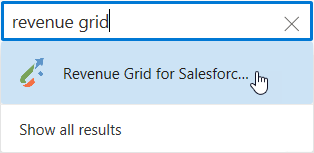
3. In the opened Add-Ins for Outlook dialog, type "Revenue Grid" in the Search box in the upper right-hand side of the dialog and select Revenue Grid for Salesforce
4. In the next dialog, click Add

You will see RG Email Sidebar icons added to MS Outlook ribbon.
After you install the Add-in for an email account, it becomes available in MS Outlook running on other configurations and devices compatible with Outlook on the Web, Outlook for Mac, iOS, or Android with the same account logged in.
Next, you need to log in to RG Email Sidebar.
Important
Before using RG Email Sidebar in MS Outlook Desktop on Windows, please make sure that you have the latest version of MS Edge installed, since it is used to render RG Email Sidebar in MS Outlook
II. RG Email Sidebar Logon¶
Note
RGES logging in is not instant: depending on the number of email messages in your mailbox and items in your calendar it may take several minutes to log in, since on logging in RGES needs to match all your existing correspondence and calendar items with your Salesforce records. That is only performed once per account
1. Open the Sidebar¶
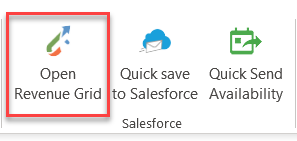
Open the Sidebar for a selected, opened or new email message in MS Outlook Desktop by clicking the Open Revenue Grid button in the ribbon.
See this article to learn how to open the Sidebar in MS Outlook on the Web.
2. Logging on to RG Email Sidebar¶
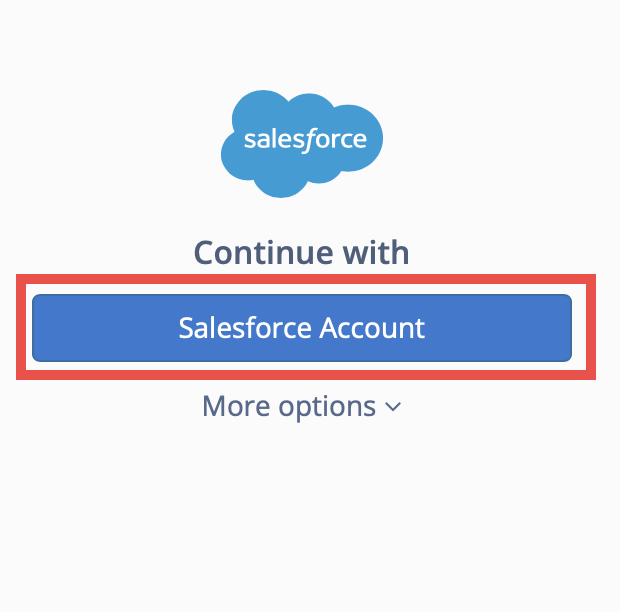
There are three available options to log in to RG Email Sidebar. Choose one of the following options to connect to Salesforce account and proceed with the steps described below:
Tip
This step can also be performed for multiple end users in bulk, by the local RGES Admin. See this article for more information
Connect to Salesforce login¶

1. Click Salesforce Account. A browser window with Salesforce OAuth page will be opened
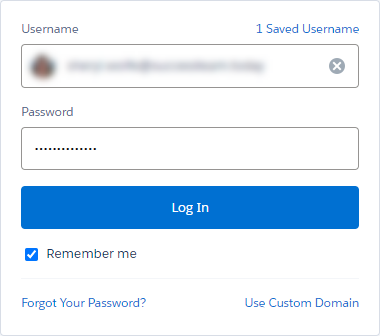
2. Enter your Salesforce credentials on the page or select a previously saved account’s username and click Log In
Note
In the screenshot above, a standard Salesforce login window is shown. Note that this OAuth window may look different depending on your Salesforce configuration
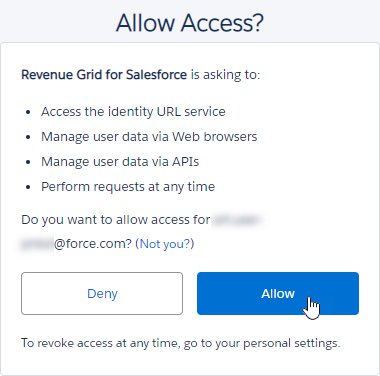
3. Next, click Allow to grant Revenue Grid Email Sidebar permissions to work with your Salesforce data
Connect to Salesforce Sandbox login¶
Tip
Salesforce Sandbox is an isolated environment with Salesforce data used for CRM system tests, learning how to use Salesforce, or experimenting with its features. Refer to this article for more information
To log in with your Salesforce Sandbox, click More options v to show this login option.

1. Click the Salesforce Sandbox button. A browser window with Salesforce OAuth page will be opened
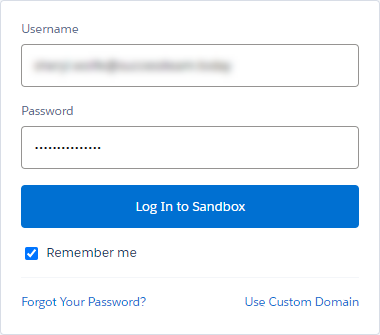
2. Enter your Salesforce Sandbox credentials on the page and click Log In to Sandbox

3. Next, click Allow to grant Revenue Grid Email Sidebar permissions to work with your Salesforce data
My Customer/Partner Community login¶
To log in with your Salesforce Customer/Partner Community, click More options v to show this login option.

1. Click the Customer/Partner Community button
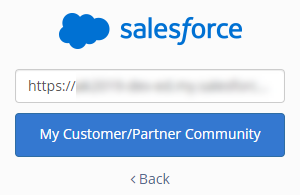
2. Enter your community access URL or your special access link in the box and click My Customer/Partner Community below the box
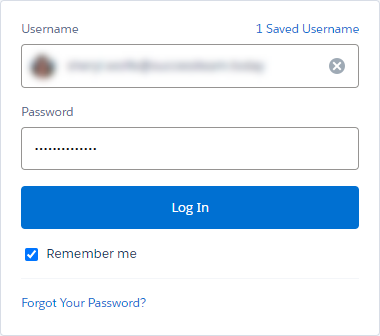
3. On the opened Salesforce OAuth page, enter your community login credentials or select a previously saved account’s username and click Log In
Note
In the screenshot above, a standard Salesforce login window is shown. Note that this OAuth window may look different depending on your Salesforce configuration

4. Next, click Allow to grant Revenue Grid Email Sidebar permissions to work with your Salesforce data
3. Activate Revenue Grid synchronization¶
Once you log in to RG Email Sidebar with your Salesforce account, you need to set up RG synchronization by authorizing it to access your MS Exchange / Office 365 data. Proceed with the steps according to the email service you are using:
If you skip this setup step, you can still run and use RG Email Sidebar, except for the key functions carried out by RGES Sync.
Important
If you are using several different mailboxes for your correspondence (not aliases), make sure to authorize RGES Sync for the same mailbox as one for which you installed the Add-in, otherwise the Sync engine functions will work incorrectly even though RGES Sync will appear to be running
Activate RGES Sync for MS Exchange¶
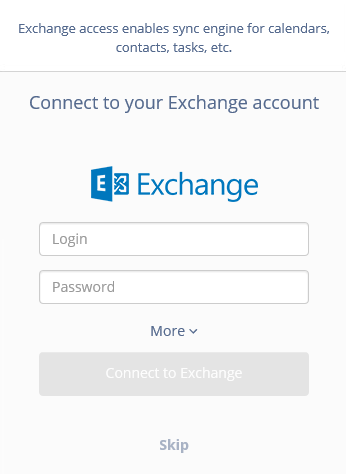
After connecting to your Salesforce account, RG Email Sidebar will ask you to connect to your Exchange account to enable RGES Sync engine.
Enter your Exchange mailbox's Login and Password and click Connect to Exchange
In some configurations, you may also need to enter a valid Exchange Web Services link specific to your company's Exchange configuration. To do that, click More v icon and paste the EWS link provided by your local Exchange Admin into the field.
After access has been authorized, RGES Sync will start running every 30 minutes 24/7 for this email account.
Activate RGES Sync for Office 365¶
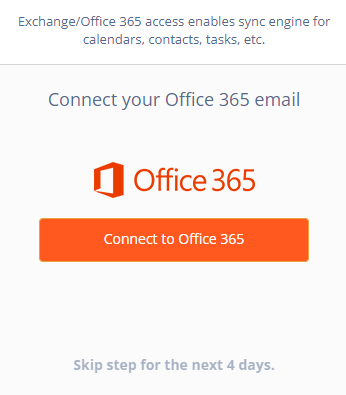
After connecting to your Salesforce account, RG Email Sidebar will ask you to connect to your Office 365 account to enable RGES Sync engine.
1. Click the Connect to Office 365 button. A browser window with Office 365 login page will be opened
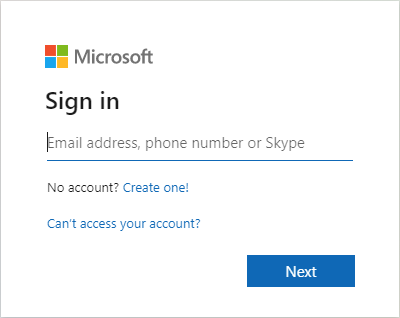
2. Enter your Office 365 login credentials in the O365 OAuth 2.0 dialog or pick an account from the list when available
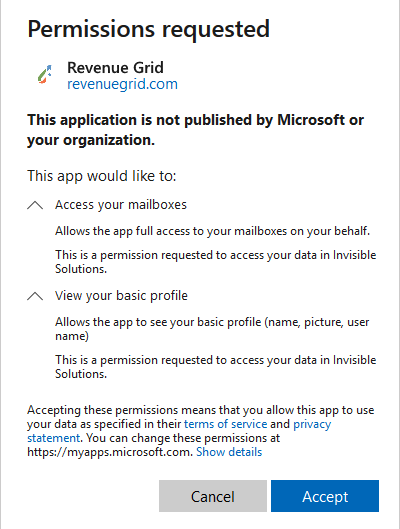
3. Next, click Accept to grant Revenue Grid Email Sidebar permissions to work with your Office 365 data
Note, that you may not see this dialog if permissions were granted earlier by you or your admin.
After access has been authorized, RGES Sync will start running every 30 minutes 24/7 for this email account.
Also, refer to these instructions if you want to pause the synchronization or completely disable RGES Sync Engine.
Note
You may update both Exchange and Salesforce accounts in sync settings at any point later. Refer to this article to learn how
Tip
Refer to this article to learn what emails and calendar items you have in MS Exchange / Office 365 will be auto-saved in Salesforce if you enable the corresponding settings (calendar items auto-saving, emails auto-saving) after setting up Revenue Grid synchronization
III. (Admins only) Install the Managed package in Salesforce¶
To enable the full scope of features offered by RG Email Sidebar several minor adjustments must be made in your Salesforce Org’s configuration; installing the Revenue Grid managed package allows to accomplish that quickly and effortlessly. Follow the above link for complete information about the package.
Note
RG Email Sidebar is based on the following fundamental principle: one email account is connected to a single Salesforce account. Therefore, no more than one business email account can be connected to a Salesforce account; for the same reason, several Salesforce accounts cannot be connected to a single email account via RGES.
However, if such scenario is required, as a workaround you can set up your email accounts each connected to a separate Salesforce account within the same Org.
Also note that RGES can automatically recognize and match different MS Exchange / Office 365 aliases used for the same email account
